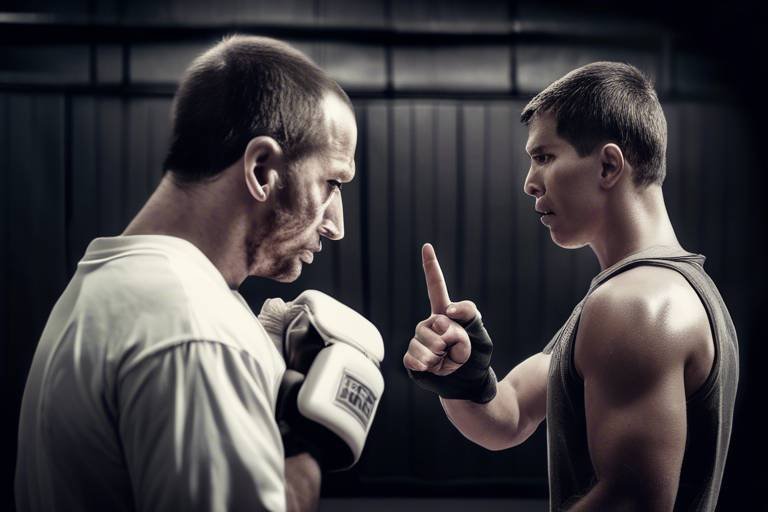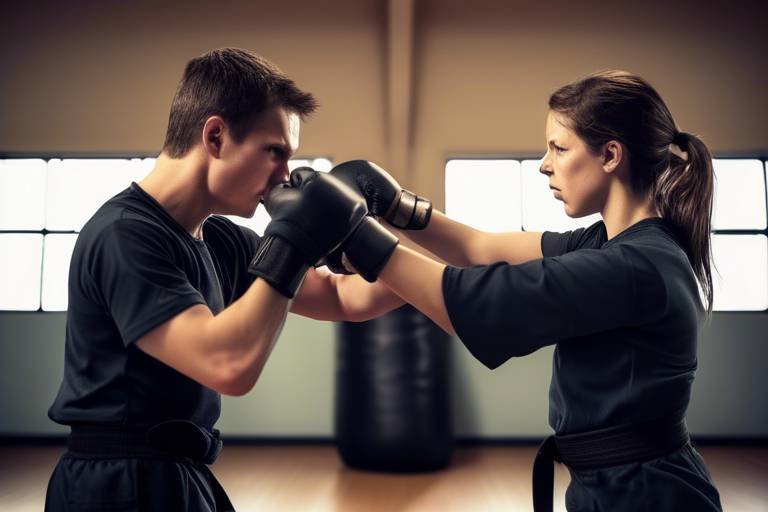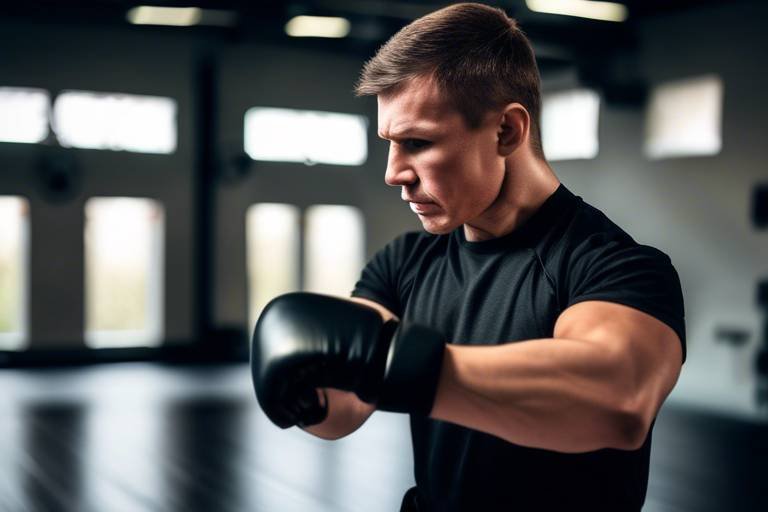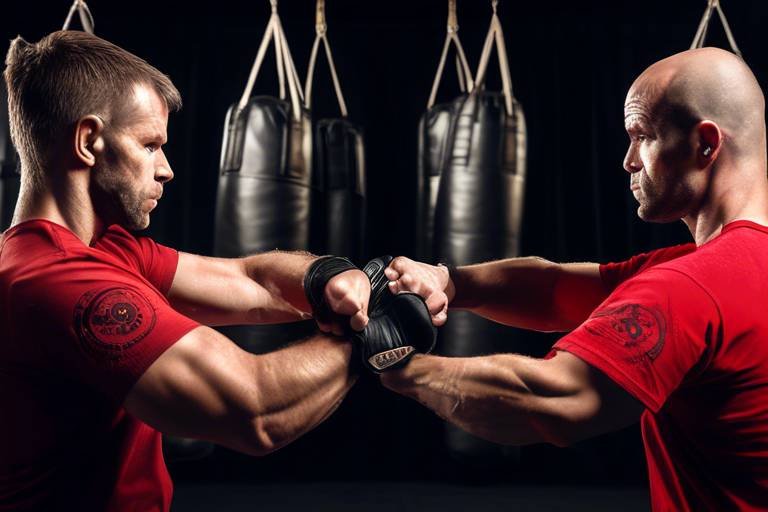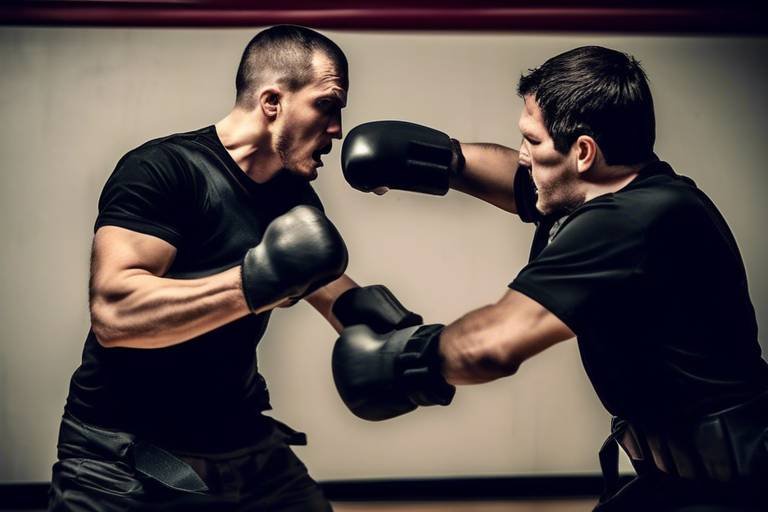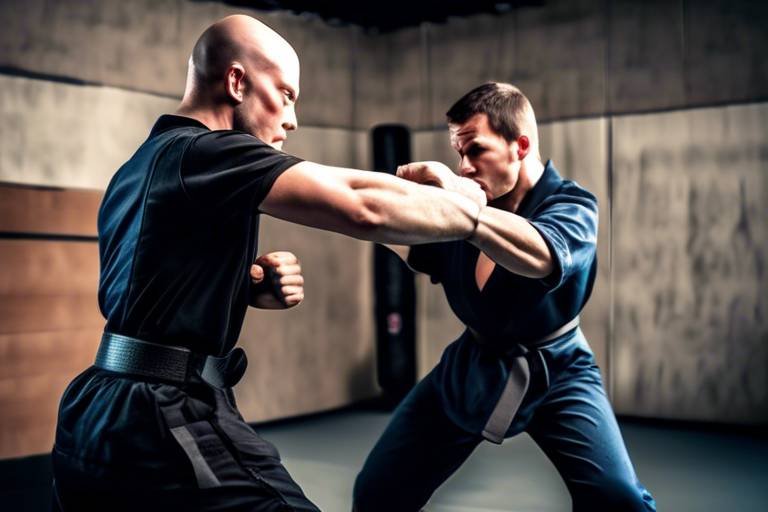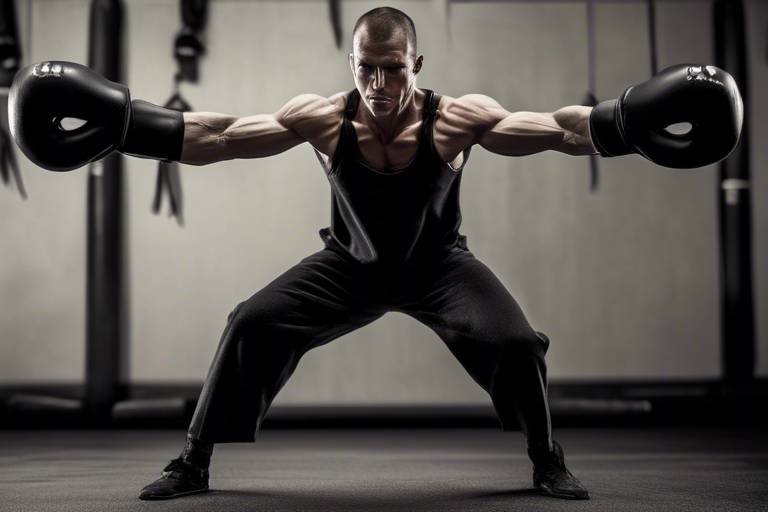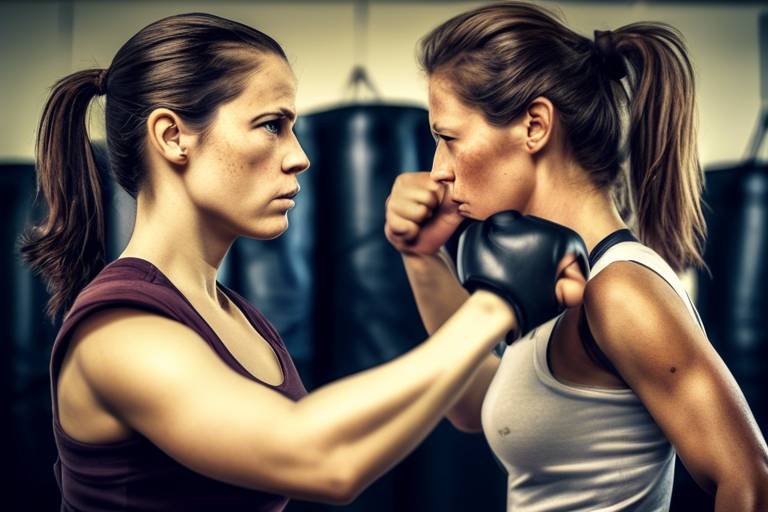Evaluating Your Progress in Self-Defense Training
When it comes to self-defense training, evaluating your progress is more than just a checkbox on a to-do list; it’s a critical part of your journey toward becoming a more competent and confident individual. Think of it as a road map that helps you navigate through the twists and turns of your training experience. By regularly assessing your skills, physical fitness, mental preparedness, and practical application, you can ensure that you're not just going through the motions but actually growing and evolving in your self-defense capabilities.
Self-defense is not merely about learning a set of techniques; it’s about developing a mindset and physicality that can respond effectively in real-life situations. As you embark on this journey, it’s essential to recognize that progress isn’t always linear. Some days will feel like a giant leap forward, while others may seem like you’re standing still. However, by establishing a structured approach to evaluation, you can gain valuable insights into your strengths and areas that need improvement.
This article will explore various methods to assess your self-defense training progress, ensuring a comprehensive evaluation of your capabilities. From setting clear goals to skill assessment techniques and physical fitness evaluations, we will cover all aspects that contribute to your growth. So, buckle up and get ready to discover how to measure your progress effectively and keep your self-defense training on the right track!
Establishing specific, measurable goals is essential for tracking your progress in self-defense training. Without clear objectives, it’s easy to get lost in the sea of techniques and drills, making it challenging to see how far you’ve come. Think of your goals as the North Star guiding you through your training journey. To create realistic objectives that align with your aspirations and personal growth, consider the following:
- Be Specific: Instead of saying, "I want to be better at self-defense," specify what that means. For example, "I want to learn three new techniques this month."
- Make It Measurable: Choose goals that you can quantify. This could be tracking the number of sparring sessions or the time it takes to complete a drill.
- Set a Time Frame: Give yourself a deadline to achieve your goals. This adds a sense of urgency and keeps you motivated.
By setting clear goals, you create a roadmap for your training, allowing you to evaluate your progress effectively and make adjustments as necessary. Remember, the journey of a thousand miles begins with a single step, and having defined goals can help you take those steps confidently.
Evaluating your self-defense skills involves various techniques, including sparring, drills, and self-assessments. These methods not only help you gauge your proficiency but also identify areas that need improvement. Imagine being an artist—each technique you learn is like a brushstroke on your canvas. The more you practice and assess, the more vibrant and impactful your masterpiece becomes.
Engaging in drills and sparring sessions provides practical experience and feedback, which are invaluable for your development. These activities serve as real-time assessments of your reaction time, technique, and adaptability. Think of sparring as a dance; the more you practice, the more fluid and instinctive your movements become. The feedback you receive from these sessions is crucial, as it highlights your strengths and exposes areas for growth.
Practicing solo drills allows for self-reflection and skill enhancement. This is your time to shine, where you can focus on perfecting your form and technique without the pressure of an opponent. Utilizing solo training effectively can help you evaluate your progress and maintain motivation. It's like having a personal training session where you’re both the coach and the athlete!
Sparring with a partner offers valuable insights into your performance under pressure. The dynamic nature of partner sparring forces you to adapt and respond in real-time, which is crucial for real-world applications. Use your partner’s feedback as a constructive tool for evaluation and improvement. Remember, every feedback is a stepping stone toward mastery!
Maintaining a training journal can significantly aid in self-assessment. Documenting your experiences and reflections helps track your progress and set future goals. It’s like having a personal coach that you can turn to at any time. By writing down your thoughts, you can identify patterns, celebrate victories, and recognize areas that need more attention. This practice not only enhances your learning but also keeps you accountable to yourself.
Physical conditioning is crucial for effective self-defense. Your fitness level directly impacts your overall training performance, so assessing it regularly is essential. Think of your body as a finely tuned machine; the better you maintain it, the more efficiently it performs. This section will examine how to assess your fitness level and its influence on your self-defense skills.
Conducting strength and endurance tests helps gauge your physical capabilities. These tests can include push-ups, squats, and timed runs. By tracking your performance over time, you can see tangible improvements that correlate with your self-defense training. It’s like measuring your progress on a scale; the numbers tell a story of your hard work and dedication!
Flexibility and agility are vital components of self-defense. Assessing these attributes can help you execute techniques more effectively. Incorporate stretching routines and agility drills into your training to evaluate and enhance these qualities. Think of flexibility as the oil that keeps your machine running smoothly—without it, you might find yourself stuck when it matters most.
Mental readiness is as important as physical skill in self-defense. Evaluating your mental state and preparedness for real-life situations is crucial. Techniques such as visualization can significantly enhance your mental preparedness. Picture yourself in various scenarios, reacting calmly and effectively; this mental rehearsal can make all the difference when faced with real challenges.
Using visualization techniques can enhance mental preparedness. Imagine yourself successfully executing techniques in high-pressure situations. This practice not only boosts your confidence but also helps you assess how well you’re mentally equipped to handle confrontations. Just like a sports player visualizes scoring a goal, you can visualize your success in self-defense.
Effective stress management is crucial for self-defense. Evaluating your coping strategies can help maintain composure during training and potential confrontations. Techniques such as deep breathing, meditation, and positive affirmations can serve as your mental toolkit. Remember, it’s about building resilience—just like a rubber band stretches but doesn’t break!
Applying self-defense skills in real-world scenarios is the ultimate test of effectiveness. This section will focus on methods to evaluate your ability to use learned techniques in practical situations. Think of it as the final exam of your training; you want to be prepared and confident when it counts.
Scenario training simulates real-life situations to assess your responses. Create effective scenarios that mimic potential threats, allowing you to practice your techniques in a controlled environment. This training not only tests your skills but also prepares you mentally for unexpected situations. It’s like a dress rehearsal before the big performance!
Receiving constructive feedback from instructors can provide valuable insights into your progress. Utilize their evaluations to identify strengths and areas for improvement. This feedback loop is essential for continuous growth and development. Think of your instructors as mentors guiding you through the intricate dance of self-defense.
Q: How often should I evaluate my self-defense progress?
A: It’s beneficial to evaluate your progress regularly, such as every few weeks or after completing specific training milestones.
Q: Can I assess my progress on my own?
A: Yes, self-assessments through journaling and solo drills can be very effective. However, feedback from instructors and training partners is also invaluable.
Q: What should I do if I feel stuck in my progress?
A: If you feel stuck, revisit your goals, seek feedback, and consider changing your training routine to reignite your motivation.
Q: How important is mental preparedness in self-defense?
A: Mental preparedness is crucial as it impacts your ability to react under pressure. Techniques like visualization can significantly enhance your readiness.

Setting Clear Goals
When it comes to self-defense training, is like having a roadmap for your journey. Without a destination in mind, you might find yourself wandering aimlessly, unsure of what you're truly capable of achieving. So, what does it mean to set clear goals in this context? It means establishing specific, measurable objectives that not only align with your training aspirations but also contribute to your personal growth.
Think of your goals as the building blocks of your training. They should be realistic and attainable while also pushing you out of your comfort zone. For instance, instead of vaguely stating, "I want to be better at self-defense," consider a more defined goal like, "I want to learn and master three new self-defense techniques within the next month." This approach not only gives you a clear target to aim for but also allows you to track your progress effectively.
To create these goals, you might want to follow the SMART criteria, which stands for:
- Specific: Clearly define what you want to achieve.
- Measurable: Include criteria to measure your progress.
- Attainable: Ensure your goals are realistic and achievable.
- Relevant: Align your goals with your overall self-defense training objectives.
- Time-bound: Set a deadline to achieve your goals.
By using this framework, you can break down your larger ambitions into smaller, manageable tasks. This not only makes the process less overwhelming but also allows you to celebrate small victories along the way. For example, if your ultimate goal is to feel confident in a self-defense scenario, you might set intermediate goals such as completing a certain number of sparring sessions or mastering specific techniques.
Moreover, it’s important to regularly revisit and adjust your goals based on your progress. As you evolve in your training, your objectives may need to shift as well. This flexibility ensures that you remain engaged and motivated, adapting to new challenges and opportunities for growth. Remember, the journey of self-defense training is not just about the destination but also about the transformation you undergo along the way.
In summary, setting clear goals is a vital step in your self-defense training. By establishing specific, measurable, attainable, relevant, and time-bound objectives, you create a structured path that guides your progress, keeps you motivated, and enhances your overall training experience.
Q: How often should I reassess my goals?
A: It's a good idea to reassess your goals every few months or after completing a significant training phase. This allows you to adjust your objectives based on your progress and any new challenges you face.
Q: What if I don't achieve my goals?
A: Don't be discouraged! Not achieving a goal is an opportunity to learn. Reflect on what may have hindered your progress and adjust your approach. Remember, training is a journey, and setbacks are part of it.
Q: Can I set both short-term and long-term goals?
A: Absolutely! In fact, it's beneficial to have a mix of both. Short-term goals can keep you motivated and provide quick wins, while long-term goals give you a broader vision of where you want to go.

Skill Assessment Techniques
When it comes to evaluating your self-defense skills, it's essential to employ a variety of assessment techniques that can provide you with a comprehensive understanding of your abilities. Just like a musician practices scales to refine their craft, you need to engage in activities that challenge your skills and help you grow. The journey of self-defense training is not just about learning techniques; it's about assessing how well you can apply them under pressure.
One of the most effective ways to gauge your proficiency is through sparring and drills. These activities serve as practical experiences that allow you to test your skills in a controlled environment. During sparring sessions, you have the opportunity to face off against a partner, simulating real-life confrontations. This not only helps you assess your reaction time but also provides valuable feedback on your technique and adaptability. Imagine it as a dance where both partners must be in sync; if one falters, the whole performance can suffer.
Engaging in both solo drills and partner sparring is crucial for your skill assessment. Solo drills allow for self-reflection, giving you the freedom to focus on specific techniques without the distraction of a partner. You can create a structured routine that targets your weaknesses, whether it's your footwork, striking precision, or defensive maneuvers. On the other hand, partner sparring introduces an element of unpredictability, forcing you to think on your feet. This dual approach ensures that you are not only honing your skills in isolation but also testing them in dynamic situations.
Utilizing solo drills effectively can be a game-changer in your training. These exercises allow you to concentrate on your form, speed, and power without the pressure of a sparring partner. You can set up a series of drills that focus on different aspects of self-defense, such as shadow boxing or practicing specific techniques against a heavy bag. Keeping a record of your solo training sessions in a journal can help you track your progress over time. By documenting your achievements and areas for improvement, you can maintain motivation and ensure that you are consistently pushing yourself.
Sparring with a partner is where the magic truly happens. It’s not just about throwing punches; it's about understanding your partner’s movements and reacting accordingly. After each sparring session, take a moment to reflect on your performance. Did you notice any patterns in your reactions? Were there moments when you felt particularly confident or unsure? Engaging in a constructive dialogue with your partner can provide insights that you may not have considered. For instance, they might point out a defensive gap you consistently leave open or a technique that you execute well. This feedback is invaluable for your growth.
Another powerful tool for skill assessment is maintaining a training journal. This simple practice can significantly enhance your self-awareness and help you track your progress over time. After each training session, take a few minutes to jot down your thoughts on what went well and what didn’t. Reflecting on your experiences can reveal patterns in your training and highlight areas that need attention. Think of it as a roadmap for your journey; without it, you might lose sight of where you’re headed.
In summary, employing a combination of drills, sparring, and self-reflection creates a robust framework for evaluating your self-defense skills. By actively engaging in these techniques, you not only enhance your abilities but also build the confidence needed to face real-world situations. Remember, the goal is not just to learn but to continually assess and refine your skills, ensuring that you are always prepared for whatever challenges may come your way.
- What is the best way to assess my self-defense skills? Engage in a combination of drills, sparring, and self-reflection to get a well-rounded perspective on your abilities.
- How often should I spar with a partner? Regular sparring sessions, ideally once or twice a week, can help you maintain your skills and adapt to different scenarios.
- Is solo training effective for skill development? Absolutely! Solo drills allow you to focus on technique and can be tailored to your specific needs.
- How important is feedback from instructors? Feedback is crucial! Constructive criticism from experienced instructors helps you identify blind spots and improve your performance.

Drills and Sparring
When it comes to honing your self-defense skills, are not just activities; they are the lifeblood of effective training. Imagine trying to learn how to ride a bike without ever getting on one—sounds ridiculous, right? That’s exactly what it’s like to skip out on these crucial components of self-defense training. Engaging in regular drills allows you to practice techniques repetitively, ensuring that they become second nature when you need them most. Whether it’s a simple jab or a complex throw, repetition breeds muscle memory, and muscle memory breeds confidence.
Sparring, on the other hand, introduces an element of unpredictability that drills alone can’t provide. It’s one thing to practice a move in isolation, but when you’re up against a live opponent, the dynamics change completely. This is where you really get to test your reaction time, technique, and adaptability. Think of sparring as a live-action simulation of a real-life confrontation. You’ll quickly discover which techniques work for you and which ones need a bit more polishing.
During these sparring sessions, it’s essential to maintain a mindset geared toward learning. You’re not just trying to win; you’re there to evaluate your performance. After each session, take a moment to reflect on what went well and what didn’t. Were you too aggressive? Did you miss opportunities to counter? This self-reflection is vital as it helps you identify areas needing improvement. To facilitate this process, consider maintaining a training journal where you can jot down your thoughts and insights after each sparring session.
Moreover, the benefits of drills and sparring extend beyond physical skills. They also enhance your mental toughness. Every time you step onto the mat, you’re not only facing an opponent but also confronting your own fears and insecurities. With each encounter, you build resilience and a stronger mindset, which are just as crucial in self-defense as physical prowess. In essence, drills and sparring are like a crucible, forging you into a more capable and confident individual.
To maximize the benefits of drills and sparring, consider incorporating various types of drills into your training regimen. Here’s a brief overview of some effective methods:
| Type of Drill | Description |
|---|---|
| Shadow Boxing | Practicing techniques and footwork without a partner to enhance form and fluidity. |
| Partner Drills | Working with a partner to practice specific techniques in a controlled environment. |
| Conditioning Drills | Incorporating physical fitness exercises to improve overall conditioning alongside technique. |
As you progress in your training, remember that the goal is to continually challenge yourself. Don’t shy away from sparring with more experienced partners; this can be intimidating, but it’s often where the most significant growth occurs. Embrace the discomfort, learn from each experience, and watch as your self-defense skills evolve.
- How often should I spar during my training? It depends on your training schedule, but sparring once or twice a week can provide a good balance of practice and recovery.
- What should I focus on during drills? Concentrate on perfecting your technique, improving your speed, and building muscle memory. Each drill should have a specific goal.
- Can I practice self-defense techniques alone? Yes, solo drills are a great way to refine your skills, but incorporating partner work is essential for real-world application.

Solo Drills
When it comes to self-defense training, are an invaluable tool for personal growth and skill enhancement. Think of them as your personal training sessions where you can focus on honing your techniques without the pressure of a partner or instructor watching your every move. These drills not only allow you to practice your skills but also provide a unique opportunity for self-reflection. Imagine you're a painter, and each stroke of the brush represents a technique you're mastering. With solo drills, you control the canvas, ensuring each stroke is executed with precision.
One of the most significant benefits of solo drills is the ability to tailor your practice to your specific needs. You can choose to focus on areas where you feel less confident or where you’ve noticed a dip in your performance during partner sessions. For instance, if you struggle with your footwork, you can dedicate an entire session to practicing movement patterns and stances. This focused approach not only builds muscle memory but also boosts your confidence, making you feel more prepared when it’s time to spar with a partner.
Moreover, solo drills can be structured in various ways to keep your training routine engaging. Here’s how you can break down your solo practice:
- Technique Repetition: Choose a specific technique and practice it repeatedly. This could be a punch, kick, or a defensive maneuver. The key is to focus on form and precision.
- Shadow Fighting: Imagine an opponent in front of you and go through your techniques as if you’re engaged in a real fight. This not only helps with technique but also improves your timing and rhythm.
- Conditioning Exercises: Incorporate physical exercises that enhance your strength and endurance, such as push-ups, squats, or jumping jacks. These will complement your self-defense skills and improve your overall fitness.
Incorporating a variety of drills will keep your sessions fresh and exciting, preventing the dreaded plateau that can occur with monotonous training. And don't forget to document your progress! Keeping a training journal where you jot down what you practiced, how you felt, and what you want to work on next can be a game changer. Not only does it help you track your improvement, but it also serves as a motivational tool. When you look back and see how far you’ve come, it’s like flipping through a photo album of your growth.
Lastly, remember that the journey of self-defense training is not just about physical ability; it’s also about mental fortitude. Solo drills provide a perfect environment to cultivate this mindset. As you practice, take a moment to visualize yourself in real-life scenarios. Picture how you would react and the techniques you would employ. This mental rehearsal not only prepares you for actual confrontations but also reinforces the skills you're developing during your drills.
In conclusion, solo drills are a vital component of your self-defense training arsenal. They offer flexibility, allow for personalized focus, and encourage both physical and mental growth. So, the next time you step onto the training mat alone, remember you’re not just practicing; you’re paving the way for your success in self-defense.
- How often should I practice solo drills? Aim for at least 2-3 times a week to see significant improvements.
- Can solo drills be as effective as partner training? Yes! While partner training offers unique benefits, solo drills are crucial for personal skill development.
- What if I don't know what to practice during solo drills? Focus on the techniques you find challenging, or ask your instructor for guidance on areas to improve.

Partner Sparring
Partner sparring is one of the most effective ways to evaluate your self-defense skills in a dynamic and realistic environment. Unlike solo drills, where you might be practicing techniques in isolation, sparring with a partner introduces the unpredictability of a real confrontation. This unpredictability is what makes partner sparring so valuable; it forces you to think on your feet, adapt your techniques, and respond to an opponent's actions in real-time. When you engage in partner sparring, you're not just testing your skills; you're also honing your instincts and reaction times, which are crucial in a self-defense situation.
During these sessions, pay close attention to the feedback you receive from your partner. Constructive criticism can be a game-changer. For instance, if your partner notices that you tend to drop your guard after executing a punch, this insight can help you focus on maintaining a strong defense. It’s also beneficial to switch roles frequently. By alternating between being the attacker and the defender, you can gain a deeper understanding of both perspectives, which enhances your overall skill set.
Another aspect to consider is the intensity of your sparring sessions. Are you pushing yourself enough? While it’s important to practice safely, you should aim to replicate the stress and pressure of a real encounter. This doesn’t mean you should go all out and risk injury, but rather find a balance where you can challenge yourself while still being aware of your partner’s safety. Keeping track of your performance during these sessions can also be beneficial. Consider maintaining a sparring log where you note down what techniques worked, what didn’t, and any feedback you received. This will help you identify patterns and areas for improvement.
In addition to skill development, partner sparring also helps in building rapport and trust with your training partner. The more comfortable you feel with each other, the more you can push each other to improve. Remember, self-defense isn’t just about physical skills; it’s also about mental preparedness and confidence. Engaging in partner sparring can significantly boost your self-assurance, making you feel more capable of handling real-life situations.
As you practice, consider incorporating various scenarios into your sparring sessions. For example, you might simulate an unexpected attack from behind or practice defending against multiple attackers. These variations not only keep the training fresh but also prepare you for a wide range of potential real-life situations. The key takeaway is that partner sparring is not just a physical workout; it’s a comprehensive evaluation tool that can significantly enhance your self-defense capabilities.
- How often should I engage in partner sparring? It's recommended to incorporate partner sparring into your training routine at least once a week to maintain and improve your skills.
- What should I do if I feel uncomfortable during sparring? Communicate openly with your partner and adjust the intensity of the sparring session. It's crucial to prioritize safety and comfort.
- Can I spar with someone of a different skill level? Yes, sparring with someone of a different skill level can be beneficial. Just ensure that both parties are aware of the goals of the session to avoid injury.

Self-Reflection and Journaling
Self-reflection and journaling are powerful tools that can significantly elevate your self-defense training. Imagine having a personal coach who’s always there to help you analyze your performance and identify areas for improvement. That’s exactly what a training journal can do for you. By documenting your experiences, thoughts, and feelings about your training sessions, you create a roadmap of your journey, allowing you to see how far you’ve come and where you need to go.
When you sit down to write in your journal, consider reflecting on various aspects of your training. For example, you might want to jot down:
- Your emotional state before and after each training session.
- Specific skills you practiced and how you felt about your performance.
- Goals you achieved or setbacks you encountered.
- Feedback you received from instructors or training partners.
This practice not only helps in tracking your progress but also fosters a deeper understanding of your strengths and weaknesses. It’s like holding up a mirror to your training; you can see the areas that sparkle and the ones that need a little polishing. Moreover, revisiting your entries can be a great source of motivation, especially on those days when you feel like giving up. It’s a reminder of your commitment and the progress you’ve made, no matter how small.
Additionally, journaling can enhance your mental preparedness. By writing down your thoughts and feelings about potential real-life scenarios, you can mentally rehearse your responses. This technique is akin to visualizing your moves before a big performance; it primes your brain for action, making you more adept at handling pressure when it counts. The more you reflect and write, the more confident you become in your abilities.
To get started, set aside a few minutes after each training session to write in your journal. You don’t need to write a novel; even a few sentences can be incredibly beneficial. Over time, you’ll develop a habit that not only enriches your training experience but also builds a solid foundation for your self-defense journey.
Q: How often should I journal about my training?
A: It's best to journal after every training session. However, if that's not feasible, aim for at least once a week to ensure you're consistently reflecting on your progress.
Q: What should I include in my self-defense journal?
A: Include your feelings before and after training, specific skills practiced, any feedback received, and your goals for future sessions.
Q: Can journaling really improve my self-defense skills?
A: Yes! Journaling helps you reflect on your experiences, understand your emotions, and visualize scenarios, all of which can enhance your mental preparedness and overall performance.
Q: What if I don’t know what to write about?
A: Start with simple prompts like "What did I learn today?" or "How did I feel during my training?" Over time, you'll find it easier to express your thoughts and insights.

Physical Fitness Evaluation
When it comes to self-defense, being physically fit is not just an added bonus; it’s a necessity. Think of your body as a finely tuned machine. If one part is out of sync, the whole system can falter, especially in high-pressure situations where every second counts. Evaluating your physical fitness is crucial to ensure that you can execute techniques effectively and respond quickly to threats. But how do you assess your fitness level? Let’s dive into some methods that will help you gauge your physical prowess and its impact on your self-defense training.
One of the most effective ways to evaluate your physical fitness is through strength and endurance tests. These tests can reveal a lot about your current capabilities and highlight areas that need improvement. For instance, you might consider performing exercises such as push-ups, sit-ups, and burpees to measure your upper body strength and core stability. Additionally, incorporating a timed run can help assess your cardiovascular endurance, which is vital for sustaining energy during a confrontation. Here’s a quick overview of some exercises you can include in your fitness evaluation:
| Exercise | Purpose | How to Measure |
|---|---|---|
| Push-Ups | Upper body strength | Max reps in 1 minute |
| Sit-Ups | Core strength | Max reps in 1 minute |
| Burpees | Full body conditioning | Max reps in 1 minute |
| 1-Mile Run | Cardiovascular endurance | Time taken to complete |
But physical fitness isn’t just about strength and endurance; flexibility and agility play a crucial role as well. Imagine trying to execute a kick or evade an attack without the necessary flexibility. It would be like trying to fit a square peg in a round hole. Therefore, assessing your flexibility through stretches and agility through drills can provide a comprehensive view of your physical capabilities. Simple tests such as the sit-and-reach test can help evaluate your flexibility, while agility ladder drills can improve your foot speed and coordination.
To sum it up, your physical fitness evaluation should encompass a variety of tests that assess strength, endurance, flexibility, and agility. By regularly measuring these attributes, you can track your progress and make necessary adjustments to your training regimen. Remember, the goal is not just to be physically fit but to be fit for self-defense. So, lace up those training shoes, grab a stopwatch, and get ready to evaluate your physical fitness!
- How often should I evaluate my physical fitness? It's recommended to assess your physical fitness every 4-6 weeks to track progress and make necessary adjustments.
- What if I struggle with certain exercises? Focus on modifying the exercises to your current fitness level. Gradual progress is key.
- Can I do these evaluations at home? Absolutely! Many of the tests can be performed in the comfort of your home or at a local park.
- Is it important to warm up before evaluations? Yes, warming up is essential to prevent injuries and ensure accurate performance during your tests.

Strength and Endurance Tests
Strength and endurance are essential components of self-defense training, as they directly influence your ability to defend yourself effectively. To truly gauge your physical capabilities, it’s crucial to conduct regularly. These tests not only provide a snapshot of your current fitness level but also help you identify areas that need improvement. Think of them as the check-up for your body’s readiness to face any challenge that comes your way.
When evaluating your strength, consider incorporating exercises like the bench press, deadlift, and squats. These compound movements engage multiple muscle groups, giving you a holistic view of your strength. For endurance, high-intensity interval training (HIIT) or long-distance running can be effective. They push your limits and help you build the stamina needed for prolonged physical encounters.
To make it easier to track your progress, you can create a simple table to record your results. Here’s an example of what that might look like:
| Test | Initial Score | Current Score | Notes |
|---|---|---|---|
| Bench Press (lbs) | 150 | 180 | Improved form and increased weight. |
| Deadlift (lbs) | 200 | 250 | Focus on core strength helped. |
| Squats (reps) | 15 | 20 | Increased stamina. |
| 1 Mile Run (min) | 10 | 8 | Improved cardiovascular fitness. |
Each time you perform these tests, aim to push your limits a bit further. This not only enhances your physical capabilities but also boosts your confidence. Remember, self-defense is as much about mental preparedness as it is about physical strength. By regularly assessing your strength and endurance, you’re not just preparing your body; you’re also building a resilient mindset.
Additionally, consider pairing these physical tests with a structured training regimen that includes rest days and recovery techniques. This ensures that your body can heal and grow stronger after each session. After all, even the most powerful machines need maintenance to keep running smoothly!
- How often should I conduct strength and endurance tests? It's recommended to perform these tests every 4-6 weeks to track your progress effectively.
- What should I do if I don't see improvement? If you're not seeing progress, consider reassessing your training regimen, diet, and recovery strategies.
- Can I do these tests at home? Yes, many strength and endurance tests can be performed at home with minimal equipment.

Flexibility and Agility Assessments
When it comes to self-defense, flexibility and agility are not just nice-to-have traits; they are essential components that can significantly enhance your performance. Think about it: in a real-life confrontation, being able to move swiftly and fluidly can mean the difference between evading an attack and being caught off guard. So, how do you assess these crucial attributes? It's all about incorporating specific tests and exercises into your training routine.
One of the most effective ways to evaluate your flexibility is through a series of stretching exercises. These not only measure your current range of motion but can also help you identify areas that need improvement. For instance, the sit-and-reach test is a simple yet revealing exercise. By sitting on the floor with your legs extended straight in front of you and reaching toward your toes, you can gauge your hamstring and lower back flexibility. Keep track of your progress over time to see how your flexibility evolves.
Agility, on the other hand, is all about how quickly and efficiently you can change direction. A fantastic way to assess your agility is through the T-test. In this test, you will set up cones in a T-shape and sprint from the starting point to the top of the "T," shuffle sideways to the left cone, shuffle to the right cone, and then backpedal to the start. This drill mimics the quick movements required in self-defense situations and provides a clear picture of your agility level.
Here’s a quick overview of some exercises you can use for flexibility and agility assessments:
| Assessment Type | Exercise | Purpose |
|---|---|---|
| Flexibility | Sit-and-Reach Test | Measures lower back and hamstring flexibility |
| Agility | T-Test | Assesses quick directional changes |
| Flexibility | Shoulder Stretch | Measures shoulder flexibility |
| Agility | Ladder Drills | Improves foot speed and coordination |
Incorporating these assessments into your training routine not only helps you identify your current capabilities but also sets a baseline for improvement. Regularly revisiting these tests can provide motivation as you see your flexibility and agility enhance over time. Remember, the goal isn’t just to pass these tests but to use them as a springboard for becoming a more well-rounded self-defense practitioner.
Ultimately, flexibility and agility are intertwined with your overall self-defense effectiveness. They contribute to your ability to evade attacks, counter effectively, and maintain balance in dynamic situations. So, don’t overlook these assessments; embrace them as a critical part of your training journey!
- Why is flexibility important in self-defense?
Flexibility allows for a greater range of motion, which can enhance your ability to escape or counter an attack. - How often should I assess my flexibility and agility?
It's beneficial to assess these attributes every few weeks to track your progress and adjust your training accordingly. - Can I improve my flexibility and agility with regular practice?
Absolutely! Consistent stretching and agility drills will lead to significant improvements over time.

Mental Preparedness
Mental readiness is just as crucial as physical skills when it comes to self-defense. After all, what good are your techniques if your mind isn't prepared to execute them under pressure? You might think of mental preparedness as the software that runs your self-defense hardware. It’s the behind-the-scenes work that ensures your body responds effectively when the situation demands it. So, how do you evaluate this critical aspect of your training?
One effective method is through the use of visualization techniques. Imagine yourself in a high-pressure situation—perhaps facing an aggressor. Close your eyes and picture every detail: the environment, your stance, the potential actions of your opponent, and your own responses. This mental imagery can help you rehearse scenarios and prepare your mind for real-life confrontations. By regularly practicing visualization, you can enhance your reaction time and decision-making skills, which are essential in self-defense situations.
Another component of mental preparedness is stress management. The ability to stay calm and collected during a confrontation can make all the difference between success and failure. You might want to evaluate your coping strategies by exposing yourself to simulated stressors during training. This could involve sparring under timed conditions or practicing techniques while under physical exertion. By doing so, you can assess how well you maintain your composure and focus. It's important to ask yourself questions like:
- Am I panicking, or can I think clearly?
- How effectively can I apply my techniques when I'm feeling stressed?
- What strategies do I have in place to calm myself down?
Additionally, consider engaging in mindfulness practices, such as meditation or breathing exercises. These techniques can significantly improve your ability to manage stress and enhance your focus. By incorporating these practices into your routine, you’ll find that your mental resilience improves, allowing you to react more effectively in high-stress situations.
To truly gauge your mental preparedness, it's also beneficial to seek feedback from your instructors or training partners. They can provide valuable insights into your mental state during training sessions. Are you hesitant? Overthinking your moves? Or are you confident and decisive? Constructive feedback can help you pinpoint areas that require further development and give you a clearer picture of your mental readiness.
In summary, evaluating your mental preparedness involves a combination of visualization techniques, stress management strategies, and constructive feedback. By focusing on these areas, you can ensure that your mind is just as prepared as your body when it comes to self-defense. Remember, self-defense isn’t just about physical prowess; it’s about a well-rounded approach that includes mental agility and resilience.
- What is mental preparedness in self-defense? Mental preparedness refers to your ability to remain calm, focused, and effective in high-pressure situations, allowing you to execute self-defense techniques successfully.
- How can I improve my mental preparedness? Techniques such as visualization, stress management exercises, and mindfulness practices can help enhance your mental readiness.
- Why is mental preparedness as important as physical skills? Without mental preparedness, even the best physical techniques may fail when faced with the stress of a real confrontation.
- How can I assess my mental preparedness? You can assess it through self-reflection, feedback from instructors, and by simulating high-pressure scenarios during training.

Visualization Techniques
Visualization techniques are powerful tools in the realm of self-defense training, allowing practitioners to enhance their mental preparedness and reaction times in high-pressure situations. Imagine standing in front of a mirror, visualizing yourself executing a perfect roundhouse kick or smoothly transitioning from a defensive stance into an offensive maneuver. This mental imagery is not just daydreaming; it's a proven method to train your brain to respond effectively when it matters most.
To effectively incorporate visualization into your training, start by finding a quiet space where you can focus without distractions. Close your eyes and take a few deep breaths to center yourself. Then, begin to visualize a specific scenario that you might encounter in a self-defense situation. For example, picture yourself walking down the street when suddenly, you notice someone approaching you aggressively. Visualize every detail: the person's movements, your own reactions, and the techniques you would use to defend yourself.
As you practice this visualization regularly, try to include various scenarios, such as:
- Defending against a grab or choke.
- Escaping from a cornered position.
- Using your environment to your advantage.
By mentally rehearsing these situations, you create neural pathways in your brain that make it easier to react instinctively in real-life encounters. It's akin to a rehearsal before a performance: the more you practice in your mind, the more confident and prepared you'll feel when the time comes to perform in reality.
Additionally, you can enhance your visualization practice by incorporating sensory details. Imagine not just the visual aspects of the scenario but also the sounds, smells, and feelings associated with it. For instance, hear the sound of your heart racing, feel the adrenaline coursing through your veins, and smell the faint scent of cologne from the approaching individual. This multi-sensory approach makes the experience more vivid and impactful, further embedding the techniques in your mind.
Moreover, consider pairing your visualization exercises with physical training. After a rigorous sparring session or drill, take a moment to visualize how you performed. Reflect on what worked well and what could be improved. This combination of physical and mental training will create a holistic approach to your self-defense preparation, ensuring that you are not only physically capable but also mentally ready to face any challenge.
In summary, visualization techniques are an invaluable asset in self-defense training. By regularly practicing mental imagery, you can enhance your reaction times, build confidence, and prepare yourself for real-world scenarios. So, the next time you step onto the mat or into the dojo, remember that your mind is just as important as your body in the journey to becoming a proficient self-defense practitioner.
Q1: How often should I practice visualization techniques?
A1: It's beneficial to practice visualization techniques daily, even if just for a few minutes. Consistency will help reinforce the mental pathways needed for effective responses in real-life situations.
Q2: Can visualization replace physical training?
A2: While visualization is a powerful tool, it should complement, not replace, physical training. Both mental and physical practices are essential for developing comprehensive self-defense skills.
Q3: What if I struggle to visualize scenarios?
A3: If you find it challenging to visualize, start with simpler scenarios or focus on the techniques themselves. Over time, as you become more comfortable, you can gradually increase the complexity of the situations you visualize.
Q4: Are there specific techniques for improving visualization skills?
A4: Yes, techniques such as guided imagery, meditation, and even using visualization apps can help improve your skills. You may also consider working with a coach or instructor who can guide you through the process.

Stress Management Strategies
When it comes to self-defense, the physical skills you develop are only half the battle. The other half involves mastering your mind, especially in high-stress situations. Think of it this way: if your body is a finely-tuned machine, your mind is the driver. Without proper mental management, even the best training can falter under pressure. So, how do you keep your cool when the heat is on? Here are some effective strategies to help you manage stress and maintain composure during training and potential confrontations.
First off, breathing techniques can work wonders. When you're in a high-pressure situation, your heart rate spikes, and your mind races. By focusing on your breath, you can regain control. Try this simple technique: inhale deeply for a count of four, hold for four, and exhale for six. Repeat this several times, and you’ll start to feel a sense of calm wash over you. This method not only helps in training but can also be invaluable in real-life scenarios where you need to think clearly and act decisively.
Another effective strategy is visualization. Imagine yourself in a stressful situation, like a confrontation. Picture how you would respond, visualize your movements, and rehearse your techniques in your mind. This mental imagery can prepare you for actual encounters and help reduce anxiety. The brain often doesn't distinguish between real and imagined experiences, so by visualizing success, you’re essentially training your mind to perform under pressure.
Moreover, mindfulness practices can significantly enhance your ability to manage stress. Engaging in activities like meditation or yoga can improve your focus and emotional regulation. These practices encourage you to be present in the moment, which is crucial when facing unexpected challenges. You might start with just a few minutes a day, gradually increasing the time as you become more comfortable. Over time, you’ll find it easier to stay centered, even in the most chaotic situations.
Lastly, don't underestimate the power of social support. Surrounding yourself with fellow practitioners who understand the challenges of self-defense training can provide a significant emotional boost. Share your experiences, discuss your fears, and learn from each other. This camaraderie not only alleviates stress but also fosters a sense of belonging and motivation. Consider joining a local self-defense group or participating in community workshops to expand your network.
In summary, managing stress in self-defense training is a multifaceted approach that combines breathing techniques, visualization, mindfulness, and social support. By integrating these strategies into your routine, you’ll not only improve your mental preparedness but also enhance your overall performance. Remember, self-defense is as much about mental resilience as it is about physical skill.
- What is the best breathing technique for stress management? The four-count breathing technique is highly effective: inhale for four counts, hold for four, and exhale for six.
- How does visualization help in self-defense? Visualization prepares your mind for real-life scenarios, reducing anxiety and improving your response during actual confrontations.
- Can mindfulness practices really make a difference? Yes! Mindfulness helps you stay present and focused, which is crucial for effective decision-making in high-stress situations.
- Why is social support important in self-defense training? Sharing experiences and learning from others can alleviate stress and provide motivation, making your training journey more enjoyable.

Real-World Application
When it comes to self-defense training, the ultimate goal is not just to learn techniques but to effectively apply them in real-world situations. This is where the rubber meets the road, and your training truly gets tested. Imagine you’re walking down the street and suddenly find yourself in a threatening situation. Will your training kick in, or will you freeze? This is why evaluating your ability to apply learned techniques in practical scenarios is crucial for your overall self-defense readiness.
One of the most effective ways to assess your skills in real-world contexts is through scenario training. This method involves simulating realistic situations that you might encounter outside the dojo or training facility. By creating these scenarios, you can evaluate your responses, decision-making, and ability to apply techniques under pressure. For instance, you might practice defending against an attacker in a crowded area, which requires not just physical skills but also the ability to think on your feet. The beauty of scenario training is that it can be tailored to reflect various situations, such as:
- Confrontations in public spaces
- Defensive strategies when cornered
- Escaping from holds or grabs
In addition to scenario training, receiving feedback from instructors is a vital component of evaluating your real-world application skills. Instructors bring a wealth of experience and can provide insights that you might overlook. After a training session, ask your instructor for constructive feedback on your performance. Questions like, “How did I handle the pressure?” or “Did I effectively apply the techniques I learned?” can help you gain a deeper understanding of your strengths and weaknesses.
Moreover, it’s essential to practice with a partner who can challenge you in ways that mimic real-life confrontations. Partner sparring not only helps you refine your techniques but also allows you to gauge your reaction time and adaptability. For example, if your partner throws unexpected punches or attempts to tackle you, how quickly can you respond? This dynamic interaction can reveal a lot about your readiness in real-world scenarios.
As you engage in these practical applications, it’s also beneficial to document your experiences. Keeping a training journal allows you to reflect on your performance, track your progress, and set future goals. After each session, jot down what worked well, what didn’t, and how you felt during the exercises. This self-reflection can be invaluable for growth and improvement.
In conclusion, the real-world application of self-defense skills is a multifaceted process that involves scenario training, instructor feedback, partner sparring, and self-reflection. By actively engaging in these practices, you can ensure that your training translates effectively into real-life situations, empowering you to respond confidently when it matters most.
Q: How can I create effective scenario training?
A: Start by identifying common self-defense situations and then design drills that simulate those scenarios. Incorporate various elements such as environmental factors, different types of attackers, and varying levels of stress to make the training realistic.
Q: What should I focus on during partner sparring?
A: Focus on applying techniques under pressure, maintaining composure, and adapting to your partner's movements. Use this time to experiment with different strategies and receive feedback from your partner.
Q: How often should I evaluate my real-world application skills?
A: Regular evaluations are essential. Aim to assess your skills every few weeks or after completing a specific training module. This will help you track progress and make necessary adjustments to your training.

Scenario Training
Scenario training is a powerful tool in the realm of self-defense, offering a unique opportunity to assess your skills in a controlled yet realistic environment. Imagine stepping into a situation where your instincts and training collide; this is where scenario training shines. By simulating real-life confrontations, you can evaluate your responses, decision-making abilities, and overall preparedness for potential threats. It’s like a dress rehearsal for your self-defense skills, allowing you to identify both strengths and areas that need improvement.
One of the remarkable aspects of scenario training is its versatility. You can create a variety of situations that mimic different types of encounters, whether it’s an unexpected attack from behind, a verbal confrontation that escalates, or even multiple assailants. Each scenario can be tailored to challenge specific skills, such as your reaction time, technique, and ability to remain calm under pressure.
To effectively implement scenario training, consider the following key elements:
- Realism: The more realistic the scenario, the better your evaluation will be. Incorporate elements like environmental factors, distractions, and varying levels of aggression.
- Feedback: After each scenario, take the time to reflect on your performance. Discuss with your training partner or instructor what went well and what could be improved.
- Variety: Don’t stick to just one type of scenario. Mix it up to expose yourself to different challenges and responses.
Additionally, it's essential to keep a training journal where you document your scenario training experiences. This practice not only helps you track your progress but also allows you to revisit your thoughts and feelings during each exercise. Over time, you’ll notice patterns in your performance, which can guide your future training objectives.
Incorporating scenario training into your self-defense regimen is not just about practicing techniques; it’s about preparing your mind and body for the unpredictability of real-life situations. By honing your skills in these simulated environments, you equip yourself with the confidence and competence needed to navigate potential confrontations effectively.
Q: What is scenario training in self-defense?
A: Scenario training involves simulating real-life situations to practice and evaluate your self-defense skills, ensuring you are prepared for various potential confrontations.
Q: How can I create effective scenarios for training?
A: To create effective scenarios, think about the types of confrontations you might face. Include elements like different environments, levels of aggression, and even multiple attackers to test your skills comprehensively.
Q: Is feedback important after scenario training?
A: Yes! Feedback is crucial as it provides insights into your performance. Discussing your actions with an instructor or training partner can highlight areas for improvement and reinforce positive behaviors.
Q: How often should I incorporate scenario training into my routine?
A: Incorporating scenario training regularly—perhaps once a week—can significantly enhance your preparedness. However, ensure you balance it with other training elements like drills and physical conditioning.

Feedback from Instructors
Receiving constructive feedback from instructors is one of the most valuable aspects of your self-defense training journey. It’s like having a personal coach who not only guides you but also helps you see your blind spots. Instructors bring a wealth of experience to the table, and their insights can be instrumental in fine-tuning your techniques and strategies. Imagine you’re a sculptor, and your instructor is the critic who helps you chisel away at the marble to reveal the masterpiece within. Their feedback can elevate your skills from basic to exceptional.
One of the key benefits of instructor feedback is the ability to get an outside perspective on your performance. Often, we might feel confident about our abilities, but instructors can identify areas for improvement that we might overlook. They observe your form, technique, and decision-making processes during training sessions. This observation is crucial because self-defense is not just about physical prowess; it’s also about mental acuity and the ability to react under pressure. For instance, instructors can highlight how your posture affects your balance or how your breathing impacts your focus during sparring.
Moreover, feedback can take many forms. It can be verbal, where an instructor provides immediate insights during or after a session, or it can be written, such as evaluations or reports that summarize your progress over time. Here’s a simple table that outlines different types of feedback you might receive:
| Type of Feedback | Description |
|---|---|
| Verbal Feedback | Immediate insights given during or after training sessions. |
| Written Evaluations | Summaries of your performance over a period, highlighting strengths and areas for improvement. |
| Peer Feedback | Insights from fellow trainees that can offer a different perspective. |
To make the most out of the feedback you receive, it’s essential to approach it with an open mind. Embrace criticism as a tool for growth rather than a personal attack. After all, even the best athletes and martial artists rely on constructive criticism to hone their skills. A great way to internalize this feedback is by keeping a training journal where you can jot down the insights provided by your instructors. This practice not only helps you remember what to work on but also allows you to track your improvement over time.
Additionally, ask questions whenever you receive feedback. If an instructor points out a flaw in your technique, inquire about specific drills or exercises that can help you improve. This proactive approach not only shows your commitment to learning but also fosters a deeper understanding of the material. Remember, self-defense training is a journey, and each piece of feedback is a stepping stone toward mastery.
Lastly, don’t forget to seek feedback regularly. It’s easy to fall into a routine where you might feel comfortable with your skills. However, consistent feedback helps push you out of your comfort zone and encourages continuous growth. So, whether it's after a sparring session or a technique drill, make it a habit to engage with your instructors about your performance. Their insights could very well be the key to unlocking your full potential in self-defense.
- How often should I seek feedback from my instructor? It's beneficial to ask for feedback after every training session, but more formal evaluations can be conducted monthly or quarterly.
- What if I disagree with the feedback I receive? It's important to consider the instructor's perspective and seek clarification. Engage in a discussion to understand their viewpoint better.
- Can I give feedback to my instructor? Absolutely! Constructive feedback can help instructors improve their teaching methods and better assist their students.
Frequently Asked Questions
- How can I set clear goals for my self-defense training?
Setting clear goals starts with identifying what you want to achieve. Are you looking to improve your technique, boost your fitness, or enhance your mental preparedness? Break down your goals into specific, measurable, achievable, relevant, and time-bound (SMART) objectives. For example, instead of saying "I want to get better at self-defense," specify "I want to practice sparring twice a week for the next month." This clarity will help you track your progress and stay motivated.
- What are some effective skill assessment techniques?
There are several techniques you can use to assess your self-defense skills effectively. Engaging in drills and sparring sessions is crucial, as they provide real-time feedback on your techniques and adaptability. Additionally, solo drills can help you focus on your form and execution without the pressure of a partner. Keeping a training journal to reflect on your experiences and progress is also an excellent way to identify areas for improvement.
- How important is physical fitness in self-defense training?
Physical fitness plays a vital role in self-defense. A strong and agile body enhances your ability to execute techniques effectively and react swiftly in high-pressure situations. Regularly conducting strength and endurance tests, along with flexibility and agility assessments, can help you gauge your fitness level. Remember, the better your physical condition, the more confident you'll feel during training and potential real-life confrontations.
- What mental preparedness techniques should I consider?
Mental preparedness is just as important as physical training. Visualization techniques can be incredibly helpful; they allow you to mentally rehearse scenarios and improve your reaction time. Additionally, developing stress management strategies is crucial. Evaluate your coping mechanisms and practice techniques like deep breathing or mindfulness to maintain composure during training and real-life situations.
- How can I apply my skills in real-world situations?
Applying your self-defense skills in real-world scenarios is the ultimate test of your training. Scenario training is a fantastic way to simulate real-life situations and assess your responses. You can create various scenarios that challenge your skills and decision-making abilities. Additionally, seeking feedback from instructors after these exercises can provide valuable insights, helping you refine your techniques and improve continuously.

